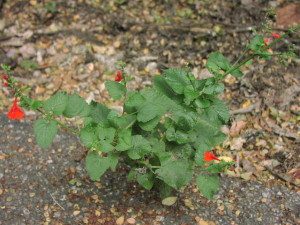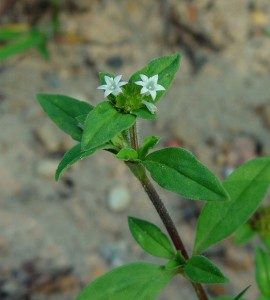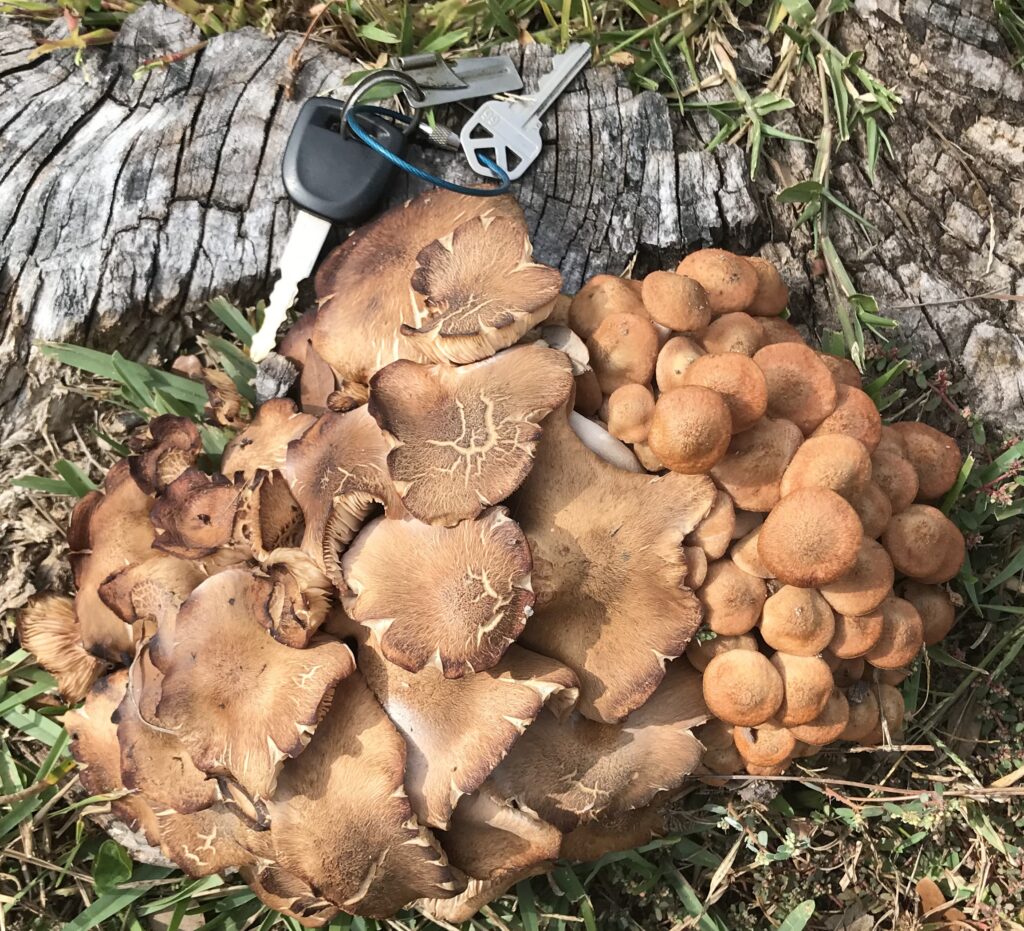
Ringless Honey Mushrooms, right on time. Photo by Green Deane
It is the ringless honey mushroom time of year, (which is a fundamental misstatement. ) One can find Ringless Honey Mushrooms any time of year. I have collected them off a Banyan in West Palm Beach in July. But usually they show up in fall, when the weather breaks to cooler days and nights. In Florida that is usually the first couple of weeks in November. In the Carolinas early September. Early cold fronts and rain can make the timing fuzzy.
The bouquet above was seen in the parking lot of the Vehicle Registry building in Seminole County, Wekiva Springs Road (there are more growing there.) I’ll eat the younger ones on our right and put the older one on some trees I want to see gone. Ringless Honey Mushrooms have a destructive relationship with living trees. To me they have a slight maple flavor. Opinions of them vary from “choice” to “not edible.” No matter how cooked they give some folks digestive upset. Try only a little at first.
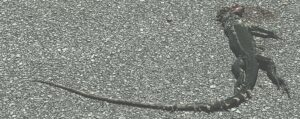
Flattened Iguanas still have several edible parts. Photo by Green Deane
What’s for dinner, besides mushrooms? When this web site was created it took the title of eattheweeds and other things too, because if you’ve ever been truly hungry you eat other things such as road kill. There used to be two road kill cafes in Florida. A year from now one might ask what is the price of meat and the answer might be half a gallon of gasoline.
Why a half a gallon? That gets my small car about 17 miles which is plenty of distance to find numerous items of road kill on SR 60 early in the morning. Instead of driving to the meat department you take a trip on a local highway, there can be plump raccoons, scrawny rabbits, lean pigs, possums, squirrels, armadillos, turtles, ducks, and deer. The latter you can legally take home. As neighbors can be spying, it is better to tell the local sheriff that you took a deer carcass home that way you can’t be accused of poaching. You cannot haul home a road kill alligator or any part there of. And they don’t taste that great. Wild Alligators are, in my estimation, famine food with a taste of the swamp.
As someone who has scraped many a meal off the road there are some “tools of the trade” I wear EMT gloves to keep from getting poison Ivy off the animal. Yes that has happened to me. Gloves and a COVID mask a good idea when handling armadillo (which after cleaning you parboil first before cooking.) And I wear a swimmer’s nose plug when cleaning possums, They have an awful aroma that does go away upon cooking.
In West Palm Beach Sunday we saw dozens of iguanas. Should there be a food shortage local residents won’t starve. The next rifle down from a .22 is a .17. They are legal most everywhere including suburbs. Besides shooting iquana a way to capture on is with a long surf -rod with a tightening loop at the end. 140 lb. fishing line is fine. They also fall out of the trees in cold weather. Just drop them into you freezer. You can read about iguanas here.
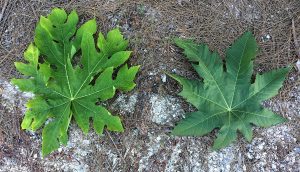
Papaya leaf on left, Castor Bean on right. Photo by Green Deane
Many botanical terms can be confusing among them palmate and pinnate. We’ll address pinnate another time. Palmate shouldn’t be difficult but it can be. It means shaped like your hand but… there are small grape leaves that are “palmate” and about the size of an adult hand. Then there are palmate leaves that are a foot across. Here are two, one from the edible Papaya tree and the other from the deadly Castor Bean. The papaya leaf, on our left, is palmate with lobes. It has seven sections, seven main veins and two sections on the bottom. Stem attachment is on the edge. The Castor Bean, right side of the photo, is also palmate but has eight sections, the sections have teeth, eight main veins total, and three sections on the lower side. Stem attachment is not on the edge. There’s more about the Papaya here.
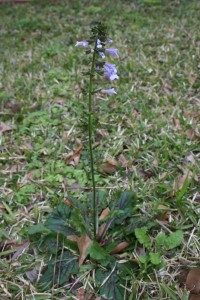
Lyre-Leaf Sage. Photo by Green Deane
In his book Edible Plants of North America, Francois Couplan writes on page 384: “the leaves of the S. lyrata, Eastern North America, contain an acrid principle and should not be ingested. They have been used to remove warts.” That said I know an herbalist who makes a tea from the leaves and a foraging instructor who cooks the young leaves and eats them. I’ve heard other reports of them being eaten. That can leave a person in a tough spot as to what to do with the plant. To eat or not to eat, that is the question.
Another example is also a sage, Salvia coccinea, also known as Tropical Sage. A small piece of the blossom of this species — a very tiny piece, 1/8 inch square — made me horribly sick for several weeks. It attacked my stomach with viciousness and I was go-to-the-emergency room miserable. Coca-cola syrup and Pepto-Bismol combined were my salvation from doubled-over pain. I was actually “field testing” this plant for edibility at the time, one reason why I am very opposed to field testing. Yet, I know of two people who have eaten the young leaves with no problem. Perhaps it was an allergy on my part. I don’t know. But I do know I will never eat any part of that plant again. Ever. Lesson painfully learned. Yet it might be edible, or maybe some folks really do have cast iron stomachs. I know I don’t. Eating this sage is one of those “you’re on your own” kind of things.
A third plant that falls into the crack between edible and not edible is Richardia scabra, aka Florida Pusley. It is in a genus that has species used to make you throw up. In fact one is called Richardia emetica. That is not encouraging. Some people mistake R. scabra for chickweed, which is a Stellaria, a totally different genus. The plants vaguely resemble each other if one ignores several details and that fact that real chickweed only grows here in the winter time. R. scabra is a species for which I have never found any ethnobotanical references to regarding edibility. In fact it is one of three common plants that seems to have either not been used by the natives or somehow were not reported. The other two are Amaranthus australis and Hibiscus moscheutos. I know from modern reports that A. australis is edible but as for the H. moscheutos I am not sure though it comes from a very edible genus. Thus R. scabra is not on my site as an edible because I can’t find any historical reference to its use. Yet I know two people who mistook it for chickweed and ate it for quite a while. And I know two people who did not mistake it; they know it is a Richardia and they eat it from time to time. That might be a key element. Without any ethnobotanical reference perhaps a little now and then is okay but a steady diet of it is not. It is one of those unknown things.

Foraging classes are held rain, shine, hot or cold. Photo by Nermina Krenata
As parks recover from Hurricane Ian we range in Central Florida this weekend, Mead GardenjJust north of Olando and Wickham Prak, Melbourne.
Saturday October 29nd, Mead Garden: 1500 S. Denning Dr., Winter Park, FL 32789.
Sunday October 30th, Wickham Park: 2500 Parkway Drive, Melbourne, FL 32935-2335 9 a.m.
For more information about the classes, to pre-pay, or to sign up go here. For all communication with me use GreenDeane@gmail.com (other emails are now not valid.)

You get the USB, not the key.
Changing foraging videos: As my WordPress pages are being updated the video set will go away. They are the same videos I have on You Tube. Some people like to have a separate copy. The DVD format, however, is becoming outdated. Those 135 videos plus 36 more are now available on a USB drive. While the videos were played from the DVDs the videos on the USB have to be copied to your computer to play. They are MP4 files. The 171-video USB is $99. If you make a $99 “donation” using the link at the bottom of this page or here, that order form provides me with your address, the amount — $99 — tells me it is not a donation and is for the USB.

Green Deane Forum
Want to identify a plant? Perhaps you’re looking for a foraging reference? You might have a UFO, an Unidentified Flowering Object, you want identified. On the Green Deane Forum we — including Green Deane and others from around the world — chat about foraging all year. And it’s not just about warm-weather plants or just North American flora. Many nations share common weeds so there’s a lot to talk. There’s also more than weeds. The reference section has information for foraging around the world. There are also articles on food preservation, and forgotten skills from making bows to fermenting food.
This is weekly newsletter #528. If you want to subscribe to this free newsletter you can find the sign-up form in the menu at the top of the page.
To donate to the Green Deane Newsletter click here.

